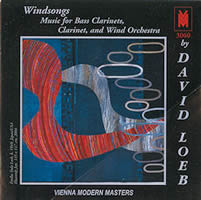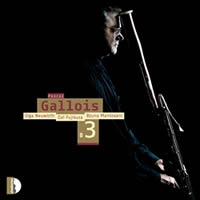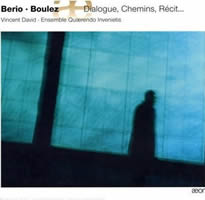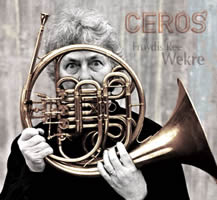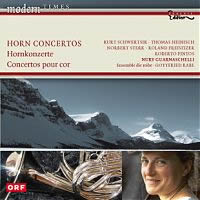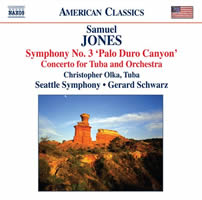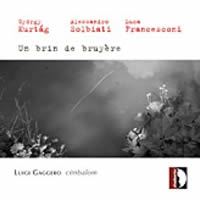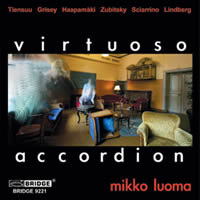Solos and Underdogs
|
Grant Chu Covell [September 2009.]
“Windsongs: Music for Bass Clarinets, Clarinet, and Wind Orchestra.” David LOEB: Double Concerto1 (1990); Voices of Winter2 (2004); Windsongs3 (2006). Henri Bok1-3, Joaquin Meijide1,3 (clars), Banda Municipal de A. Coruña, Marcel van Bree (cond.). Vienna Modern Masters VMM 3060 (http://www.viennamodernmasters.at/). Distributed in the US by CDeMusic (http://www.cdemusic.org/). Bass clarinetist Bok neatly cements the prolific Loeb’s release (the composer’s five solo bass-clarinet sonatas fill Vienna Modern Masters VMM 2040). Low, breathy woodwind timbres are among my favorites (there’s a great passage in the first movement of Mahler’s Ninth), and the two double concertos offer ample room for dexterity and color. The supporting wind band works to fine effect in these slightly Stravinsky- and jazz-tinged works.
“Pascal Gallois #3.” Olga NEUWIRTH: In Nacht und Eis* (2006); zefiro aleggia…nell’ infinito…† (2004); Torsion (2003). Daï FUJIKURA: The Voice* (2007). Bruno MANTOVANI: Un mois d’octobre** (2000). Pascal Gallois (bsn), Rohan de Saram* (vlc), Dimitri Vassilakis** (pno), Deutsches Symphonieorchester, Brad Lubman† (cond.). Stradivarius STR 33799 (http://www.stradivarius.it/). Distributed in the US by Allegro Music (http://www.allegro-music.com/). One of Gallois’ earlier releases was covered here, and this third production centers around substantial works by Neuwirth: In Nacht und Eis, a duet for bassoon and ring-modulated cello, zefiro aleggia…nell’ infinito…, for bassoon and orchestra, and Torsion for bassoon and CD. Neuwirth’s tendency for strident textures and irreducible structures is ever apparent. In the duet, electronics twist de Saram’s sound into barbed wire. Comparatively plain, Fujikura’s The Voice, also for cello and bassoon, plays on the pair’s similarities for a lyrical duet. A galaxy away from Stravinsky’s innovative Rite of Spring opening, Mantovani’s Un mois d’octobre (bassoon and piano) reminds that Gallois is the bassoon glissando king. A looped tape suggesting a village klezmer band leaks into Neuwirth’s zefiro aleggia…nell’ infinito… and the same material appears in the CD-plus-bassoon Torsion. Online sources imply Torsion’s structure is a theme and variations, perhaps applicable to the concerto work.
“Dialogue, Chemins, Récit…” Luciano BERIO: Chemins IV (1975); 14 Duos (from the 34 Duetti for two violins) (1979-83); Récit (Chemins VII) (1995). Pierre BOULEZ: Dialogue de l’ombre double (2001). Anton WEBERN: Quatuor, Op. 22 (1930). Vincent David (saxophones), Ensemble Quaerendo Invenietis, Renaud Déjardin (cond.). Aeon AECD 0860 (http://www.aeon.fr/). Distributed in the US by Allegro Music (http://www.allegro-music.com/). I confess that Boulez’s Dialogue de l’ombre double in its original scoring for clarinet and electronics leaves me cold. The play between a live instrument and its pre-recorded or spatially manipulated double may satisfy Boulez’s intellectual aims, but the hues tend towards gray over the 17-plus minutes. Because David’s saxophones offer perkier colors, I was more attentive to this arrangement (Pascal Gallois also offers a version for bassoon). Berio’s violin duos with saxophone taking either one or both parts are sparkling, playful miniatures. Chemins IV and Récit are somber ensemble works wherein the sax floats over dense string webs. The Webern almost seems like an afterthought or encore — only Berio and Boulez appear on the spine and front cover. Compared with the Webern’s dodecaphonic facets, the two Bs more resemble Romantics.
“Ceros.” Wolfgang PLAGGE: Raga, Op. 1061 (2000); Monoceros, Op. 512 (1990); Sonata No. 4 for Horn and Piano, Op. 1153 (2002). Sigurd BERGE: Horntrio4 (1986). Trygve MADSEN: Trio, Op. 1105 (1998). Johan KVANDAL: Salmetone6 (1985). Andrea CLEARFIELD: Into the Falcon’s Eye7 (2003). Frøydis Ree Wekre1-7, Lisa Ford4,7, Jan-Olav Martinsen1,4 (hrns), Atle Sponberg5 (vln), Tor Espen Aspaas5, Wolfgang Plagge1,3, Andrea Clearfield7 (pnos). 2L 25 (http://www.2l.no/). Distributed in the US by Naxos (http://www.naxos.com/). I’ve frequently revisited this 2005 disc because of Wekre’s divine playing. Five of the seven works were either commissioned by or dedicated to Wekre when she was a member of the Oslo Philharmonic (1961-1991). Plagge’s Raga and Clearfield’s Into the Falcon’s Eye are for two horns and piano. Berge’s Horntrio is for three horns, whereas Madsen’s Trio is for violin, horn and piano. Plagge’s Monoceros and Kvandal’s Salmetone are solos. Wekre’s silky tone, precisely expressive, distinguishes her from two former students, Ford and Martinsen. Consequently, the two solo-horn pieces end too soon for this listener. None of the works is exceptionally modern, though Clearfield’s Falcon makes use of glissandos. Madsen’s Trio alludes to Brahms via a gentle French café breeze. The Plagge and Berge scores can be found at http://www.2l.no/.
“Horn Concertos.” Roland FREISITZER: Music for horn and 11 musicians (2007). Thomas HEINISCH: Chimäre, Musik für Horn und Kammerensemble (2006-07). Norbert STERK: “…und leuchteten das Dunkel aus” für Horn und Ensemble (2006). Kurt SCHWERTSIK: In keltischer Manier für Alphorn in Ges und Kleines Orchester, Op. 27 (1975). Roberto PINTOS: Concierto para Corno y Ensamble. Nury Guarnaschelli (hrn); Ensemble “die reihe,” Gottfried Rabl (cond.). Phoenix Edition 131 (http://www.phoenixedition.com/). Distributed in the US by Naxos (http://www.naxos.com/). This collection of predominantly contemporary German concertos for horn may at first glance appear one of the most esoteric releases imaginable. The Heinisch and Sterk concertos do blur with their caramel hues, long-held tones and overall weightiness. Heinisch’s single movement contains some Scelsi-like swirling. Sterk’s contribution may perhaps be the most conventional. Freisitzer’s Music warrants revisiting, employing phrase repetitions precisely like Bernhard Lang to create an unsteady lurching. A number of scraps are easily mistaken for Feldman or Berg. Schwertsik may be the most familiar name here (conductor Rabl and composer/conductor Freisitzer follow right behind). The four movements, “in Celtic style,” require an alphorn in the remote key of G-flat, with the differently tuned natural notes offering a spiced harmonic palette for the folksy material which seems more Continental than Celtic. Argentine-born Guarnaschelli requested the inclusion of her compatriot, Pintos’ Concierto, a spirited single movement which buoyantly indulges in nationalistic styles. With its strong tango blood, no one would confuse it with the four German pieces.
Samuel JONES: Concerto for Tuba and Orchestra (2005); Symphony No. 3, “Palo Duro Canyon” (1992). Christopher Olka (tuba), Seattle Symphony, Gerard Schwarz (cond.). Naxos 8.559378 (http://www.naxos.com/). Opening with a Till Eulenspiegel-like flourish, Jones’ fluid concerto reminds us that the often-misunderstood tuba is capable of great agility and expansive lyricism. Nothing in Jones’ sweeping concerto, or his Third, would be out of place in a Hollywood blockbuster. Indeed his Eastman School pedigree and studies with Hanson reflect this. There are infrequent moments where Jones may have wanted to explore his mid-Western-Prokofievian inclinations, but such outbursts are restrained. Subtle and overt Wagner references live in the concerto’s finale. The work was written in memory of James P. Crowder, an aeronautical engineer fond of Wagner’s Ring. The Amarillo Symphony commissioned the single-movement Third and premiered it in the Palo Duro Canyon State Park, some 20 miles southeast of Amarillo, TX. Its broad design opens with taped wind noises, thence to grandeur.
Luciano BERIO: SOLO (1999, rev. 2000). Iannis XENAKIS: Troorkh (1991). Mark-Anthony TURNAGE: Yet Another Set To (2004, rev. 2005). Christian Lindberg (trb), Oslo Philharmonic Orchestra, Peter Rundel (cond.). BIS-SACD-1638 (1 SACD) (http://www.bis.se/). Distributed in the US by Qualiton (http://www.qualiton.com/). I jumped into this release thinking the Xenakis and Berio would be the ones to write about. Imagine my surprise to report that the Turnage is this disc’s high point, a jazzy, boisterous three-movement gallop. Admittedly bits of the Turnage, in the first movement, Cut Up, strongly recalled the Andriessen release “De Stijl / M is for Man, Music, Mozart” (Nonesuch 79342-2). Berio’s contribution fails to sustain attention: A solo trombone and orchestra neither interact nor cohere. Perhaps that is why the piece is called SOLO as a lengthy joke that proves to be lame. Lindberg’s powerful agility deceives us into thinking the Xenakis is easy. We’re told there are 56 high Fs and three high G-flats which should render this concerto impossible, yet Lindberg dispatches them effortlessly, having worked on technique for about two years simply in order to negotiate aspects of Troorkh, a made-up word combining the first syllables of “trombone” and “orchestra.” Manipulating dense chords with a light hand, Xenakis’ writing is unexpectedly calm.
“Un brin de bruyère.” György KURTÁG: Un brin de bruyère (1994); Szálkák, Op. 6/c (1962/1973); Tre pezzi per clarinetto e cimbalom, Op. 38* (1996); Tre altri pezzi per clarinetto e cimbalom, Op. 38a* (1996); Hommage à Berényi Ferenc 70 (1997). Alessandro SOLBIATI: Quaderno d’immagini — 8 pezzi per cimbalom (2002); Tre duetti da Piccoli canti† (1996). Luca FRANCESCONI: Etude (2001). Luigi Gaggero (cimbalom), Freyja Gunnlaugsdóttir*† (clar), Michela La Fauci† (hp), Andrea Moretti† (vibr). Stradivarius STR 33785 (http://www.stradivarius.it/). Distributed in the US by Allegro Music (http://www.allegro-music.com/). The cimbalom’s twangy tone suggests a cross between a piano and a donkey. This Stradivarius release offers the crispest, most present cimbalom recording I’ve heard. All the pieces spark and crackle. Kurtág’s miniatures include Un brin de bruyère, written in memoriam Lutosławski, and a birthday greeting for Ferenc Berényi. The Op. 38 collections can’t fail to amuse: Both sets of “three pieces” for clarinet and cimbalom each contain more than three pieces. The near-nothing gradual attack of the clarinet is cleverly contrasted with the quickly vanishing cimbalom pluck. Solbiati’s pieces bring the cimbalom into the modern world, whereas in Kurtág’s music the feel is that of a faded daguerreotype. Dedicated to Kurtág, Solbiati’s Tre duetti pair cimbalom with harp, clarinet and vibraphone. At a little over five minutes, Francesconi’s Etude is the disc’s longest entry, centering on gloominess not present in the other works.
“Ceci n’est pas une guitare.” Ulrich KRIEGER: Histoire de l’œil+ (2007). György KURTÁG: A kis csáva, Op. 15b* (1978). Steve REICH: Nagoya guitars (1995). Toshio HOSOKAWA: Renka I (Manyô-shû)† (1986). Georges APERGHIS: Conversation XX (1985-2007). Hugues DUFOURT: La cité des saules+ (1997). Toru TAKEMITSU: Toward the sea‡ (1981). Eve BEGLARIAN: Until it blazes (2001). Emanuele E. Forni (gtrs), Andreas Pfiffner+(electronics), Simon Röthlisberger* (trb), Angela Tschanz* (picc), Tatiana Ďurišovᇠ(alto-fl.), Noe Ito† (voice). Stradivarius STR 33775 (http://www.stradivarius.it/). Distributed in the US by Allegro Music (http://www.allegro-music.com/). Guitarist Forni offers a wide variety of solo and small-group pieces requiring acoustic and electric guitars: impressionistic pieces by Takemitsu (for guitar and alto flute), Kurtág’s aphoristic miniatures for the obscure trio of piccolo, trombone and guitar, and a generous helping of somewhat minimal works requiring electronics. In this last category are Krieger’s gradually ascending process piece Histoire de l’œil, Reich’s Nagoya guitars and Beglarian’s Until it blazes, which can also be performed on piano. The most mystifying piece is Dufourt’s La cité des saules which somewhat distorts the guitar’s sound. Aperghis’ tiny Conversation XX is an amuse-bouche pairing spoken syllables with gestures.
“Virtuoso Accordion.” Sampo HAAPAMÄKI: Power (2001). Jukka TIENSUU: Aufschwung (1977); Zolo (2002). Vladimir ZUBITSKY: Carpathian Suite (1974). Salvatore SCIARRINO: Vagabonde blu (1988). Gérard GRISEY: Passacaille (1967). Magnus LINDBERG: Jeux d’anches (1990-91). Mikko Luoma (accordion). Bridge Records BRIDGE 9221 (http://www.bridgerecords.com/). An agile Luoma offers up an arresting program of contemporary accordion music. Haapamäki’s Power and Tiensuu’s Aufschwung and Zolo plumb the accordion’s potential with rapid figurations and crunching chords. Zubitsky’s four-movement suite belabors folk tunes. Sciarrino’s grand Vagabonde blu contrasts extreme pitches against lulling chords, as if the instrument were breathing fitfully in its sleep. Passacaille is an early Grisey composition with fulsome harmonies quite unlike the composer’s later spectralist explorations. Lindberg’s Jeux d’anches swirls and swoops. Tiensuu’s energetic Zolo incorporates pitch bending and furniture-rattling clusters. The recording is first-class — cover and tray pictures show the same room, with several differences suggesting a clandestine narrative. I have to think that Luoma has a wry sense of humor: He appears on BIS 1107 in Juhani Nuorvala’s solo-accordion What’s a Nice Chord Like You Doing in a Piece Like This which briefly suggests a mainstay polka.
Aperghis, Beglarian, Berge, Berio, Boulez, Clearfield, Dufourt, Francesconi, Freisitzer, Fujikura, Grisey, Haapamaki, Heinisch, Hosokawa, Jones, Kurtág, Kvandal, Loeb, M Lindberg, Madsen, Mantovani, O Neuwirth, Pintos, Plagge, Reich, Schwertsik, Solbiati, Sterk, Takemitsu, Tiensuu, Turnage, U Krieger, Webern, Xenakis, Zubitsky
[More Grant Chu Covell]
[More
Aperghis, Beglarian, Berge, Berio, Boulez, Clearfield, Dufourt, Francesconi, Freisitzer, Fujikura, Grisey, Haapamaki, Heinisch, Hosokawa, Jones, Kurtág, Kvandal, Loeb, M Lindberg, Madsen, Mantovani, O Neuwirth, Pintos, Plagge, Reich, Schwertsik, Solbiati, Sterk, Takemitsu, Tiensuu, Turnage, U Krieger, Webern, Xenakis, Zubitsky]
[Previous Article:
Album Tweets 1.]
[Next Article:
Golden Oldies: A Century of Singing]
|
